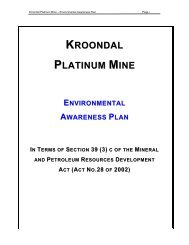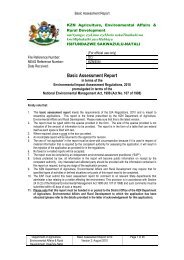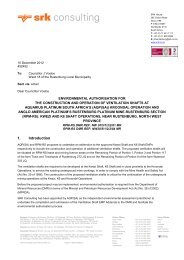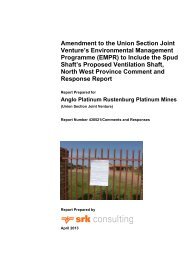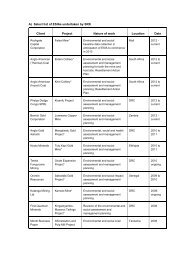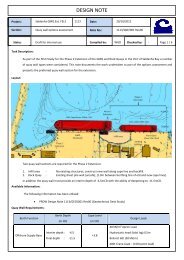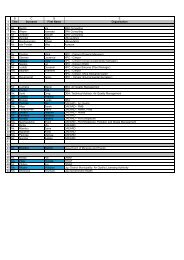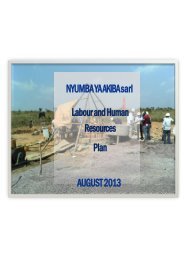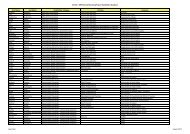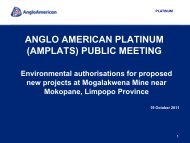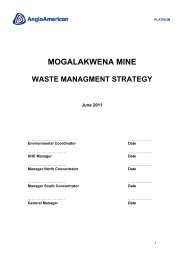Biodiversity (1 - SRK Consulting
Biodiversity (1 - SRK Consulting
Biodiversity (1 - SRK Consulting
Create successful ePaper yourself
Turn your PDF publications into a flip-book with our unique Google optimized e-Paper software.
Very few trees occur on the study site, which provided habitat for arboreal (tree-living)<br />
herpetofauna. As a result arboreal species like the Kalahari tree skink are excluded from<br />
the species list.<br />
The farm owner, Mr Deon Maasdorp, gave me a list of herpetofauna species he has<br />
found on his farm. Some interesting observations he and his family have make in the<br />
few years they have farmed on the study site, were that they have never seen a single<br />
frog, but have observed rock monitors on the property.<br />
Of the 56 reptile species, which are deduced to possibly occupy the study site (Table 1),<br />
six were confirmed during the site visit (Table 2) and of the possible 11 amphibian<br />
species which may occur on the study site (Table 1), none was confirmed during the site<br />
visit (Table 2). The number of species would certainly have been higher if the survey<br />
had been conducted during the summer months, especially after good rains. The three<br />
Red Data reptiles which may occur on the study site are discussed below. No exotic<br />
herpetofauna species are expected to occur on the study site.<br />
The species assemblage is typical of what can be expected in a fairly natural<br />
environment, with sufficient habitat to sustain populations. Most of the species of the<br />
resident diversity (Table 1) are fairly common and widespread (viz. Karoo tent tortoise,<br />
brown house snake, common egg eater, puff adder, horned adder, Cape cobra, Bibron’s<br />
tubercled gecko, giant ground gecko, Anchieta’s agama and western rock skink).<br />
The high species richness expected on the study site is due to the size of the study site,<br />
the renowned endemic biodiversity of the Northern Cape and the presence of three of<br />
the four habitat types. The excellent presence of rupiculous habitats have also enhanced<br />
the species richness.<br />
10.3. Red Data Listed Reptiles<br />
The study site area falls outside the natural range of the speckled padloper, Namaqua<br />
day Gecko, Lawrence’s girdled lizard, Armadillo girdled lizard, Lomi’s blind legless skink,<br />
120



